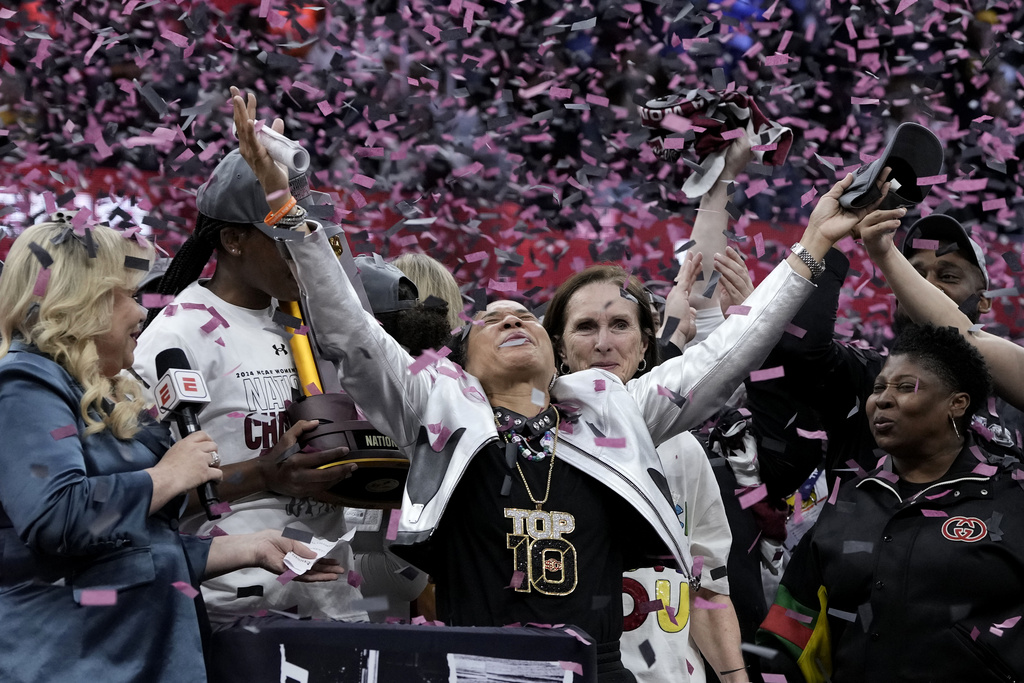NCAA Women’s Final Crushes Men’s Viewership — Making Fragile Haters Look Like Buffoons

AP Photo/Morry Gash
Something of a miracle occurred in the past days: for the first time in history, the women’s NCAA final had much higher TV ratings than the men’s counterpart.
Given the years of March Madness promotion and major network carriage of men’s games — let alone the cottage industry of brackets and betting — it’s more than noteworthy that the women’s final was far more popular this year and suggests the dawn of a new era of interest in women’s sports. What’s more, it makes the criticism of grievance-mongers like Clay Travis look moronic in hindsight. More on that in a minute…
The women’s NCAA championship game, held on Sunday afternoon, blew the men’s title game, which tipped off Monday evening at 9:20 p.m., out of the water. The women’s final on ESPN had an average of 18.9 million viewers watching undefeated South Carolina beat Iowa and superstar Caitlin Clark, according to Nielsen ratings released Tuesday. Monday’s men’s final between UConn and Purdue, in which the Huskies defeated the Boilermakers 75-60, averaged 14.82 million on TBS and TNT.
There are good reasons for this, namely that the women’s final featured a generational star in Clark going up against one of, if not the best, college basketball coaches, Dawn Staley, who was trying to lead her team to an impossibly undefeated record of 38-0. The women’s tournament had already established viewer momentum, featuring the two most-watched women’s basketball games of all time. A late Sunday tip-off probably didn’t hurt much, either.
However, the number of viewers Nielsen posted on Monday was stunning as it was the highest-rated basketball game aired on television in years. The only other recently televised sporting events that have rated higher? NFL games and tentpole events like the Olympics and the World Cup. More importantly, it continued a ratings trend that saw a 90% increase from last year and a 280% increase in the prior year.
Programmers at TBS and NCAA will almost certainly look at the 9:20 tip-off and how that was likely too late for many East Coast viewers. And apart from a few upsets and folk heroes like NC States DJ Burns, this year’s men’s tournament lacked drama, especially heading into the final. Purdue and UConn were the best teams all season, and the Huskies’ back-to-back title felt inevitable. Hell, even I had them picked to win it all, which isn’t that shocking given their season.
But these aren’t excuses, nor should there be any real concern for the men’s game moving forward. It’s just that the women’s tournament was way more interesting this year. Caitlan Clark even said she felt more excitement surrounding the women’s tournament than the men’s, which caused derision from certain male fragile precincts. And there may be no better avatar than male fragility than Outkick founder and Fox News blowhard Clay Travis.
In late March, he posted a video on social media stating: “The Wall Street Journal and the New York Times are both arguing that women’s college basketball is now more popular than men’s college basketball. This is identity politics insanity and pure falsehood.”
He then said:
The NCAA tournamen dwarfs — for men — the NCAA tournament for women. This is an indisputable fact. Tens of millions of more people will watch the NCAA men’s tournament than the women’s tournament. This is an indisputable truth. It always has been that way. I believe it always will be that way. Men are bigger, stronger and faster. That makes men’s basketball more fun to watch. To most people than women’s basketball at all levels. That’s why the NBA players make $50 million a year. And the WNBA players make $50,000 a year. It’s because the men’s game is far more exciting and the men are bigger, stronger and faster.
He then cited a Wall Street Journal column titled “Is Caitlin Clark Bigger Than the Men’s NCAA Tournament?” and reads the following passage: “Heading into Selection Sunday, it’s become all but impossible to deny that for the first time ever, the women’s tournament is shaping up to be a bigger deal than the men’s.”
“The notion that the men’s I’m reading directly from their article, the notion that the men’s NCAA tournament, long the crown jewel of college sports, would ever get overshadowed by the women’s event, would have been completely unthinkable just a few years ago,” Travis states. “Again, they start with a false premise that the women’s tournament is bigger than the men’s tournament.”
Now, taken in aggregate, there is no question that the total number of men’s tournament viewers is exponentially greater than that of women’s games. That is an undeniable fact. But Travis’s anger that the women’s tournament is a “bigger deal” than the men’s reveals a strange and unhealthy level of fragility at play. Also, judged purely by interest in the title game, Travis’s cocksure dismissal seems entirely misguided.
The women’s championship game was great — next year, we will likely see a return to more traditional ratings patterns, but the fact that the women outdrew men? It’s a historic moment rooted in the passing of the massively culturally shifting legislature known as Title IX, and we should all celebrate.
Here’s the real beauty part: nothing will drive equal payment between men and women athletes more quickly than increased television ratings. I am an enormous supporter of both the men’s and women’s US national teams and have pointed out that pay inequality is far more complicated than it is made out to be.
The Men’s World Cup prize is four times greater than that of the women’s tournament, mainly due to advertising deals and a far more extensive viewer base. More eyeballs, more ad revenue, greater prize money.
Women’s soccer is a relatively new phenomenon and probably one of the greatest legacies of the genuinely game-changing Title IX legislation of 1972. International women’s soccer is still not the global phenomenon that the men’s version is. The first Women’s World Cup was held in 1991, and the first men’s version was held in 1930.
That truth can be applied to all of women’s sports which is why Jason Sudekis can be seen wearing a hoodie that encourages people to watch women’s sports. It’s good for everyone, especially those of us who want to see kids raised by confident and happy parents who have benefited from competing in organized sports.
Congratulations to Dawn Staley and the South Carolina Gamecocks. You hosted a trophy Sunday night, but what you and the Caitlan Clark-led Iowa Hawkeyes accomplished was so much more.
This is an opinion piece. The views expressed in this article are those of just the author.






